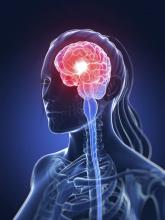Los Angeles – Cluster headache, a severe, one-sided headache that occurs in cyclical patterns or clusters, is highly associated with smoking, but when it presents in people without any lifetime tobacco exposure, there are key differences – possibly due to a different underlying pathology.
At the American Academy of Neurology annual meeting, Todd D. Rozen, MD, of the Mayo Clinic in Jacksonville, Fla., presented a new analysis from the United States Cluster Headache Survey, an online survey of 1,134 patients with cluster headache, of whom only 12% reported neither personal tobacco use nor a parent who smoked. Dr. Rozen is a coauthor on the original survey, which collected data for a two-month period in late 2008, and has published several analyses using the survey’s data (Headache. 2012 Jan;52[1]:99-113).
The latest analysis “is , and they’re different,” he said in an interview. People with cluster headaches who never smoked, and who did not grow up in a smoking household, tend to develop cluster headache at a younger age, have a more episodic pattern of disease and are less likely to present with agitation and suicidal ideation compared with those who smoke, smoked, or had a parent who smoked, Dr. Rozen found.Patients not exposed to tobacco developed cluster headache at a younger age than exposed subjects, with a significantly higher percentage reporting onset in their 20s and 30s, while tobacco-exposed people were more likely to see onset at aged 40 years or older.
And there were other important differences. The tobacco-naïve were more likely to have a family history of migraine (65% vs. 50%, P equal to .002). They were significantly more likely to have headache cycles that varied throughout the year rather than being concentrated during specific months or seasons (52% vs. 40%, P equal to .02), which is a hallmark of cluster headache.
Tobacco-exposed patients were more likely to transition from episodic to chronic cluster headaches (23% vs. 14%, P equal to .02) and to have cycles lasting 7 weeks or more (54% vs. 35%, P equal to .0003) compared with those who were tobacco-naïve. They also reported significantly more frequent attacks per day, and were more likely to develop cluster headache during the night (12 pm to 6 am).
“With cluster headache, the majority of patients smoke, and started smoking before they ever developed cluster headache,” Dr. Rozen said. Among the tobacco-exposed patients in the survey, 85% had what he described as a “double hit” – a parent who smoked and a personal history of smoking. “And that may be what’s necessary to develop cluster headache of this classic type,” he said.


